L.A. Noire Review
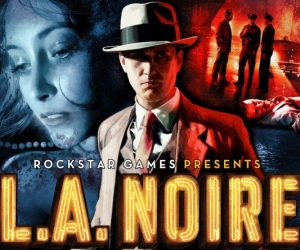 Game: L.A. Noire
Game: L.A. Noire
Developer: Team Bondi, Rockstar Games
Publisher: Rockstar Games
Available on: Xbox 360, PlayStation 3, PC and OnLive (Xbox 360 version reviewed)
“Revolutionary” is not a wise word to use in any context. But in the video game world, where technological innovations take place on a monthly basis, such a term seems particularly hyperbolic.
Much has been said about L.A. Noire’s pioneering facial animation technology, which is supposed to capture expressions so precisely that players are able to use their most basic human instincts to deduce whether or not a character is telling the truth. Such was the hype surrounding this mechanic that the game may well have topped this week’s charts had Team Bondi simply shoehorned it into a version of Grand Theft Auto IV with a jazz soundtrack. The fact that they instead chose to strip away many of the conventions we associate with the open-world genre and replace them with something altogether more sparse and cerebral is testament to their bravery, not to mention publisher Rockstar’s faith.
STORY: The player assumes the role of Cole Phelps, a veteran of the United States Marine Corps who joins the LAPD to gain closure after his traumatic experiences fighting the Japanese in World War II. Although Phelps initially appears to be a morally upstanding young police officer, he has a darker streak which is slowly revealed through flashbacks, ultimately manifesting itself in ill-advised decisions in the present day.
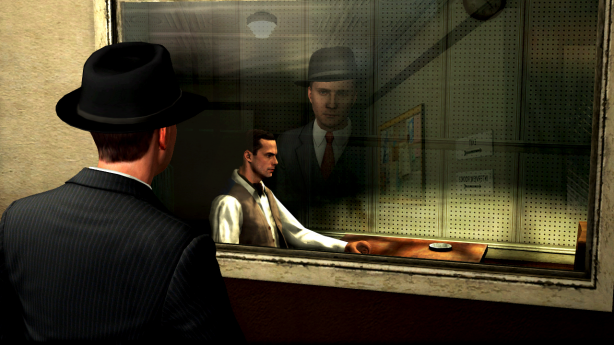
The “present day” is actually 1947, in booming post-war Los Angeles. The setting will be familiar to aficionados of author James Ellroy and the film adaptations of his work, especially L.A. Confidential and The Black Dahlia. Largely shunning cartoonish depictions of Hollywood for a high-contrast rendering of the city’s bleaker neighbourhoods, L.A. Noire explores the narratively rich territory of a sinister metropolis lurking behind a pastel facade of prosperity and glamour.
Like the detectives in Ellroy’s novels, Phelps’ ability to solve the cases he is assigned to is directly correlated with the depth of his involvement with them. In order to uncover the truth behind a series of grisly murders which run parallel to Ellroy’s depiction of the real-life murder of Elizabeth “Black Dahlia” Short, Phelps frequently finds himself embroiled in the murky underworld of Los Angeles. As the game progresses, it becomes increasingly clear that he must choose between preserving his peaceful family life and unearthing the horrors that lurk beneath the city’s candy-coloured suburbs.
More disturbing still is the fact that the largest obstacle Phelps encounters in his quest for truth is not a criminal gang or an underworld boss, but the LAPD itself. Politics poison the integrity of the Los Angeles Police Department and corrupts the justice system to the point where the most horrific acts of violence are brushed aside with handshakes and photo opportunities.
It is the inevitability of Phelps’ decision to uncover the rotten heart of the establishment that makes his downward spiral so compelling. To live in the Los Angeles depicted by the game is to make the decision between corrupt survival or honest self-destruction. It is a choice faced by all the characters in L.A. Noire’s bitter universe, and one which resonates heavily with the player long after the final credits have rolled.
GRAPHICS: The much-anticipated facial animation is as gobsmacking as you have been led to believe. For those of us who felt we had lost the ability to be astonished by video game graphics, LA Noire delivers a swift left hook. As gamers, we have become accustomed to the slightly wooden expressions displayed by the in-engine versions of our favourite characters. These faces convey information rather than expressing it, leaving the voice actors solely responsible for any emoting required. In contrast, L.A. Noire employs a multiple-camera technique similar to The Matrix’s “bullet-time” to record the performances of actors from all possible angles.
Such is the realism achieved by this technology that the player’s reaction initially tumbles right to the bottom of the uncanny valley. There is something deeply unsettling about the characters’ apparent humanity in a medium which is completely inorganic. What makes Phelps and the other characters fascinating rather than monstrous is the fact that they are performed by real actors, rather than being entirely simulated.
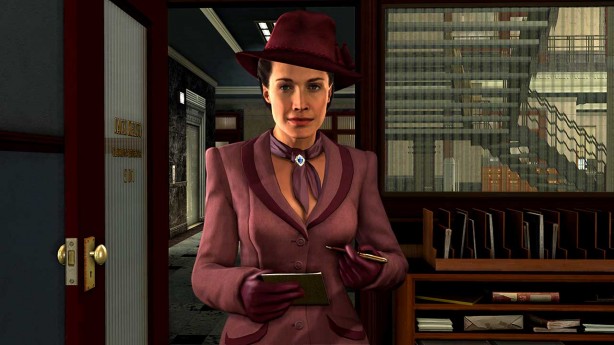
You’re likely to recognise a good few of the performers if you have watched any American television dramas over the last decade. As L.A. Noire requires physical performances as well as vocal ones, it features a cast of conventional actors rather than voice artists. Luckily, the odd familiar face does not detract too much from the game’s immersion because the actors all seem to be in familiar territory, and have been chosen for their abilities rather than the star-power attached to their names.
SOUND: Due to the nature of the performances in L.A. Noire, it is almost impossible to separate vocal delivery from the rest of the acting. That said, although the game challenges established notions of video game characterisation, certain recognisable techniques are still employed, such as the extensive bank of phrases which Phelps’ various partners utter whenever Phelps crashes the car.
That’s not to say that L.A. Noire draws upon GTA’s distinctive brand of anarchic slapstick for its script. On the contrary, the whole thing is played straight. There are deeply unpleasant characters, to be sure, but they aren’t caricatures and they don’t spout catchphrases. Similarly, whilst the cars have radios, there’s no satire at work across the broadcasts. Music is a combination of period recordings and original compositions, and whilst the former bestows a sense of time and place upon the game, the latter gives it a dramatic edge.
The game also features optional musical clues to aid crime scene investigations. Confident players (or those who like to role-play) will want to disable these assists, but those who weren’t raised on a solid diet of point-and-click adventures will find that the increasing volume of the double bass (warmer, warmer…) and the tinkling of the piano (boiling!) won’t intrude too much on the game’s immersive feeling.
GAMEPLAY: Despite being an open-world game, L.A. Noire’s gameplay is lean, sparse and focused. It’s not a sandbox title in that the player is never not on a mission. There’s no travelling to a trigger point or choosing what you want to do next, and you simply progress from one investigation to another. Whilst this is likely to frustrate many players, others will applaud Team Bondi for the bravery they have shown in shunning most of the compulsory minigames and collectibles that go with the open-world territory.
Although players can photograph the recreations of Los Angeles’ 1940s landmarks and respond to calls for back-up over the police radio, L.A. Noire’s focus is securely on investigation and interrogation. The game is structured around a series of consecutive “cases” which may or may not be related to each other. Most cases begin on a crime scene, which the player must explore, looking for clues. Whilst footprints and wallets make for predictable pieces of evidence, would-be detectives will also find themselves examining more mundane objects which might hold the key to a case. All relevant evidence is automatically listed in Phelps’ investigation notebook, and can be used to direct further investigation or interrogate suspects.
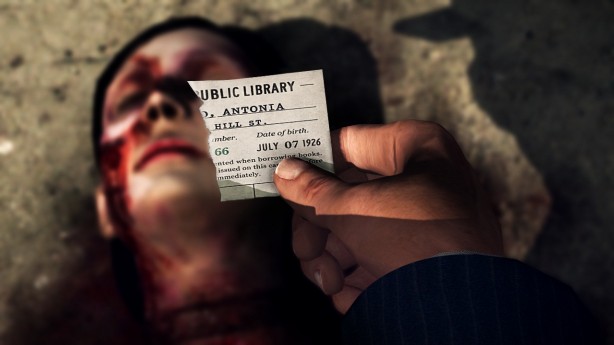
The interrogation scenes are the most problematic yet fascinating aspect of the game. For players who occasionally find it hard to follow complicated plots (such as this reviewer), the dialogue trees are extremely rewarding, but their formulaic nature can prove frustrating for players with greater powers of deduction.
Phelps enters each interrogation armed with a few lines of enquiry and any evidence the player has succeeded in obtaining throughout the investigation. Players can choose which line of enquiry to pursue, and watch as the suspect provides an answer before deciding whether or not they are telling the truth. If you’ve managed to find a piece of evidence that proves a character is lying (and have the intellectual wherewithal to make the necessary mental connection), you can back the suspect into a corner, and often secure a conviction. If you don’t have any proof, your only options are to either believe the suspect and coax more information out of them, or “doubt” their testimony, unsettling them and causing them to spill their story.
To make this choice, you must rely on the facial animations to clue you into whether or not the suspect is lying. Cues that a character is telling porkies include pronounced swallowing, nervous twitches and eyes which nervously scan the room for an escape route. In order for this to work, not one character in L.A. Noire is a good liar. Without fail, every single person you interview will display some kind of nervous tic which betrays them. It’s a small immersion-breaker, to be sure, but one that’s completely understandable given the ambition of what Team Bondi are trying to achieve.
A larger issue is the fact that the evidence-collection system does not allow for players who figure out a solution independently to capitalize on their powers of deduction. There is no way to circumnavigate blind avenues of investigation, as certain conversations or locations are only “unlocked” once specific pieces of evidence are collected. In this sense the game is more akin to point-and-click adventure games than to a truly dynamic world. There is sometimes a feeling that one is dutifully picking up various objects just so Phelps will put an entry in his notebook and stick a marker on the map. Although the game’s logic never falters (there are no “combine the rubber duck with the nail file to create a floating key” howlers), it’s hard to believe that you are truly investigating something when you have figured out the answer already.
That said, this is an issue which will only trouble the most consistently perceptive players, and even they should be mollified by the bravery of L.A. Noire’s overall execution. Although the game wisely concentrates on cerebral challenges, it still contains driving sequences and a small amount of action and gun-play. These are extremely well-delivered and display the same polished restraint exhibited by the game’s visuals and storyline. Driving is a particular pleasure because the 1940s family saloons aren’t often found in video games. The city is a joy to drive through, if not for its beauty (Los Angeles’ flat, square sprawl has never been elegant) then for its period detailing and utter believability. Because you lose points for damaging the environment and injuring pedestrians, you are encouraged to drive carefully, which is a feature that increases the sense of immersion.
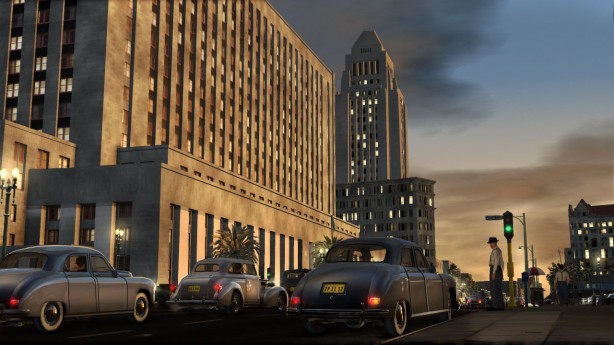
The tension of the shooting sequences is increased by the wise decision to dispense with not only a health bar, but ammunition as well. Although Phelps can pick up discarded guns, the amount of ammunition they contain is never disclosed, meaning that you’re never quite sure how many shotgun shells you have left before you have to return to the pistol. Although there are a few action sequences which stretch the bounds of plausibility, on the whole the game maintains an impressive focus which never allows the plot to be diluted by over-the-top pyrotechnics.
LONGEVITY: With its lack of superfluous collectibles and side-quests, L.A. Noire finishes with its central storyline. Unlike other open-world games, you cannot walk the city streets after the main quest has finished and tidy up loose ends. The decision to omit such narrative decoration serves the plot well, but it leaves little reason to return to the Los Angeles streets.
Whilst there is an argument for replaying the game for the sake of streamlining your investigations and outwitting suspects with the benefit of hindsight, this rather defeats the point of playing through a detective story. There are a couple of occasions in the game where you can make a choice between charging one suspect or another, but this only impacts upon your end-of-case report rather than the outcome of the plot in general.
That said, although the main game might not offer much in return for the time invested in playing it twice, it’s likely that the promised DLC will yield rich rewards, and at roughly twenty hours, the story is ample value for money. We might have heard the last of the protagonists in this particular story, but there’s plenty of mileage in the world itself.
VERDICT: Although the linearity of a central game mechanic which should be completely fluid holds L.A. Noire back from perfection, the crisp certainty of the game’s execution raises it far above average. What’s more, the gameplay is so closely tied to the narrative that there is no sense of wasted time or energy. This is a game which cannot be played or understood without a certain commitment to the plot, something rarely seen outside the realms of the point-and-click. In this way, L.A. Noire betrays its noble origins. It is at heart an adventure game, one which compels its player to take notice of their environment and the characters around them if they are to succeed.
Remarkable even more for its restraint than for its dazzling technology, this is a game which never compromises its vision of the story it sets out to tell. Rarely has a developer had so much opportunity to bundle everything but the kitchen sink into a new IP, and rarely has the result shown such admirable self-control. With its single-minded commitment to a story told with the kind of technological wizardry normally reserved for explosive action titles, L.A. Noire is a magnificent achievement. Whether future games build upon its innovation remains to be seen, but it’s safe to say that as far as video game storytelling goes, L.A. Noire is indeed revolutionary.





